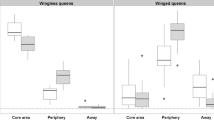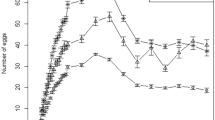Summary
The nests of the Neo-GuineanNasutitermes polygynus Roisin and Pasteels and the NeotropicalN. costalis (Holmgren) are polycalic. Seventy percent of theN. polygynus nests and half theN. costalis nests were found to be devoid of royal nodule and reproductives. Two polycalic systems ofN. polygynus revealed the presence of functional reproductives in more than one calie, thus suggesting a process of colony reproduction by budding.
Multiple imaginal queens are extremely frequent in both species: inN. costalis, all the 14 nests with reproductives were polygynous, whereas inN. polygynus, only one nest of 14 was monogynous. The proportion of polygynous societies is much higher in these species than in any other termite so far studied. Multiple kings are usually associated with polygyny.
The numbers of functional sexuals encountered in the two species are also exceptional: up to 105 queens inN. polygynus, 97 inN. costalis.
The coexistence of queens of different generations, recognizable by their sclerite pigmentation, occurred in fourN. polygynus and twoN. costalis nests. The younger queens are usually more numerous and smaller than the older ones.
In both species, the average size of the queens is negatively correlated with their number. Average egg production rates were recorded inN. polygynus. They are in good correlation with the queens' average fresh weight.
A colony ofN. polygynus orphaned by removal of the five constituting calies recovered and rebuilt two new nests, in both of which hundreds of young adultoid replacement reproductives were found.
Observations on swarming and postflight behaviour ofN. costalis do not support the possibility that polygynous associations result from foundation in common after swarming.
The ecological significance of polycalism, the relationships between queen age, number and physogastry, and the methods of formation of polygynous associations are discussed.
Resume
Les nids du termite de Nouvelle-GuinéeNasutitermes polygynus Roisin et Pasteels et de l'espèce néotropicaleN. costalis (Holmgren) sont polycaliques. Soixante-dix pour cent des nids deN. polygynus et la moitié des nids deN. costalis récoltés étaient dépourvus de nodule royal et de reproducteurs.
Dans deux systèmes polycaliques deN. polygynus, des sexués fonctionnels étaient présents dans plus d'une calie, suggérant un mode de reproduction des sociétés par bourgeonnement.
Des reines imaginales multiples se rencontrent très fréquemment chez les deux espèces: chezN. costalis, les 14 nids récoltés pourvus de sexués étaient polygynes, tandis que chezN. polygynus, un seul nid sur 14 était monogyne. La polyandrie est habituellement associée à la polygynie.
Les nombres de sexués rencontrés dans les deux espèces sont aussi exceptionnels: jusqu'à 105 reines chezN. polygynus, 97 chezN. costalis.
La coexistence de reines de générations différentes, reconnaissables à la pigmentation de leurs sclérites, a été notee dans quatre nids deN. polygynus et deux nids deN. costalis. Les reines les plus jeunes sont généralement plus nombreuses et moins physogastres que les plus âgées.
Chez les deux espèces, la taille moyenne de l'abdomen des reines est corrélée négativement à leur nombre. Le taux moyen de production d'œufs, relevé chezN. polygynus, est en bonne corrélation avec le poids frais moyen des reines.
Une colonie deN. polygynus, rendue orpheline par la récolte des cinq calies constitutives, a pu reconstruire deux nouveaux nids; dans chacun d'eux, plusieurs centaines de jeunes sexués de remplacement adultoïdes étaient présents.
Il ne semble pas, d'après des observations sur l'essaimage deN. costalis, que des associations polygynes puissent résulter de la fondation de colonies en commun par plus d'un couple d'essaimants.
La signification écologique du polycalisme, les relations entre l'âge, le nombre et la physogastrie des reines, et les modes de formation des associations polygynes, font l'objet d'une discussion.
Similar content being viewed by others
References
Bathellier J., 1927. — Contribution à l'étude systématique et biologique des termites de l'Indochine.Faune des Colonies Françaises, 1, 121–365.
Coaton W.G.H., 1948. —Trinervitermes species. The snouted harvester termites.U. South Africa, Dept. Agric. Entom., Ser. 23, 19 p.
Escherisch K., 1911. —Termitenleben auf Ceylon, G. Fischer Verl., Jena, 179 p.
Fletcher D.J.C., 1984. — Castes and roles in reproduction among social insects.Actes Coll. Insectes Soc., 1, 5–17.
Grassé P.P., 1949. — Ordre des Isoptères ou Termites. In: P.P. Grassé (éd.),Traité de Zoologie, Anatomie, Systématique, Biologie, Masson, Paris, vol. IX, 408–544.
Grassé P.P., Noirot C., 1948. — La biologie et les constructions du termiteApicotermes arquieri, n. sp. C.R. Acad. Sci. Paris, 227, 735–736.
Harris W.V., 1961. —Termites, their recognition and control, Longmans, Green and Co., Ltd., London, XII + 187 p.
Hill G.F., 1942. —Termites (Isoptera) from the Australian Region, Commonwealth of Australia, C.S.I.R., 479 p., 24 pl.
Hölldobler B., Wilson E.O., 1977. — The number of queens: an important trait in ant evolution.Naturwissenschaften, 64, 8–15.
Holt J.A., Easey J.F., 1985. — Polycalic colonies of some mound building termites (Isoptera: Termitidae) in Northeastern Australia.Ins. Soc., 32, 61–69.
Josens G., 1972. — Etudes biologique et écologique des termites (Isoptera) de la savane de Lamto-Pakobo (Côte d'Ivoire).Doctoral Thesis, University of Brussels, 285 p.
Levings S.C., Adams E.S., 1984. — Intra- and interspecific territoriality inNasutitermes in a Panamaniam mangrove forest (Isoptera: Termitidae).J. Anim. Ecol., 53, 705–714.
Nutting W.L., 1969. — Flight and colony foundation. In: Krishna K., Weesner F.M. (eds),Biology of Termites, Academic Press, New York,vol. 2, 233–282.
Oster G.F., Wilson E.O., 1978. —Caste and Ecology in the Social Insects, Princeton University Press, XV + 352 p.
Renoux J., 1976. — Le polymorphisme deSchedorhinotermes lamanianus (Sjöstedt) (Isoptera: Rhinotermitidae). Essai d'interprétation.Ins. Soc., 23, 279–494.
Roisin Y., Pasteels J.M., 1985 a. — Imaginal polymorphism and polygyny in the Neo-Guinean termiteNasutitermes princeps (Desneux).Ins. Soc., 32, 140–157.
Roisin Y., Pasteels J.M., 1985 b. — A newNasutitermes species from New Guinea.Indo-Malay. Zool., 2, 315–330.
Roisin Y., Pasteels J.M., 1986. — Replacement of reproductives inNasutitermes princeps (Desneux) (Isoptera: Termitidae).Behav. Ecol. Sociobiol., in press.
Roisin Y., Pasteels J.M., Braekman J.C., 1986. — Soldier diterpene patterns in relation with aggressive behaviour, spatial distribution and reproduction of colonies inNasutitermes princeps. Biochem. Syst. Ecol., in press.
Sieber R., Darlington J.P.E.C., 1982. — Replacement of the royal pair inMacrotermes michaelseni.Insect Sci. Application, 3, 39–42.
Sieber R., Leuthold R.H., 1982. — Development of physogastry in the queen of the fungus-growing termiteMacrotermes michaelseni (Isoptera: Macrotermitinae).J. Insect Physiol., 28, 979–985.
Snyder T.E., Zetek J., 1924. — Damage by termites in the canal zone and Panama and how to prevent it.Bull. U.S. Dept. Agric., Washington D.C.,No. 1232, 25 p.
Thorne B.L., 1982 a. — Polygyny in termites: multiple primary queens in colonies ofNasutitermes corniger (Motschulsky) (Isoptera: Termitidae).Ins. Soc., 29, 102–117.
Thorne B.L., 1982 b. — Reproductive plasticity in the Neotropical termiteNasutitermes corniger. In: P. Jaisson (ed.),Social Insects in the Tropics, vol. 1, Paris, 21–29.
Thorne B.L., 1984. — Polygyny in the Neotropical termiteNasutitermes corniger: life history consequences of queen mutualism.Behav. Ecol. Sociobiol., 14, 117–136.
Thorne B.L., 1985. — Termite polygyny: The ecological dynamics of queen mutualism. In: Hölldobler B., Lindauer M. (eds),Experimental Behavioral Ecology and Sociobiology, G. Fischer Verlag, Stuttgart, 325–341.
Traniello J.F.A., 1981. — Enemy deterrence in the recruitment strategy of a termite: Soldier-organized foraging inNasutitermes costalis.Proc. Natl. Acad. Sci. U.S.A., 78, 1976–1979.
Weyer F., 1930. — Beobachtungen über die Entstehung neuer Kolonien bei tropischen Termiten.Zool. Jahrb. (Syst.), 60, 327–380.
Author information
Authors and Affiliations
Additional information
King Leopold III Biological Station, Laing Island, Papua New Guinea, contribution no. 98.
Rights and permissions
About this article
Cite this article
Roisin, Y., Pasteels, J.M. Reproductive mechanisms in termites: Polycalism and polygyny inNasutitermes polygynus andN. costalis . Ins. Soc 33, 149–167 (1986). https://doi.org/10.1007/BF02224595
Received:
Accepted:
Issue Date:
DOI: https://doi.org/10.1007/BF02224595




